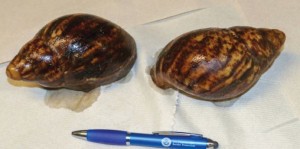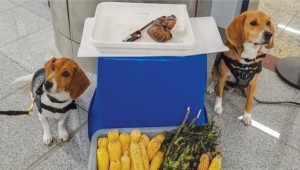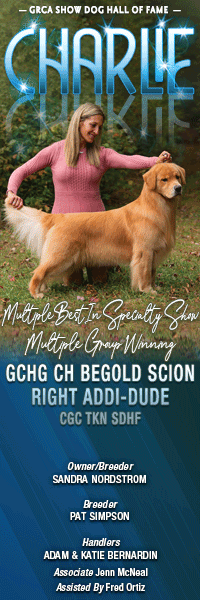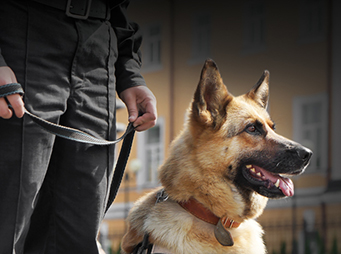Here’s How the AKC Dog Detection Task Force Is Helping to Improve Our National Security at the Borders
Click here to read the complete article
218 – September 2019
In a country with more than 80 million dog owners, why is there still a shortage of dogs that are needed to protect the borders, airports, cities, schools, malls, entertainment events and nuclear plants. Most Americans are unaware of this shortage even though it is not new. The problem significantly increased following the events of 9/11, Brussels, Boston, Las Vegas, New York and London. As other terrorist events and natural disasters began to occur, most countries began to buy up the supply of working dogs for their own protection. According to the Departments of Defense and Homeland Security, about 90 percent of the detection and patrol dogs in the US come from overseas breeders. The dependence on European breeders to supply a needed resource was not acceptable to the Federal Government, and during the past 50 years, four separate Federal breeding programs were established only to close each of them because of a budget cut or a lack of funding. The last closing in 2012 demonstrated that this problem needed the involvement of the private sector.
 In 2016, the U.S. Senate held three hearings regarding the security of our airports, borders and infrastructure and the need for dogs that could detect explosives. Following those hearings, the AKC was asked to help because of its 130,000 breeders, 5,000 clubs and 22,000 events held each year. When, in 2017, the AKC was again asked by the government and private sector to help, the Board responded by establishing the AKC Dog Detection Task Force with a small pilot program involving about 90 breeders and several adjunct breeds. The breeders involved agreed to produce litters and hold back at least one pup from each litter that would undergo advanced socialization and enrichment techniques and eventually become a working detection dog.
In 2016, the U.S. Senate held three hearings regarding the security of our airports, borders and infrastructure and the need for dogs that could detect explosives. Following those hearings, the AKC was asked to help because of its 130,000 breeders, 5,000 clubs and 22,000 events held each year. When, in 2017, the AKC was again asked by the government and private sector to help, the Board responded by establishing the AKC Dog Detection Task Force with a small pilot program involving about 90 breeders and several adjunct breeds. The breeders involved agreed to produce litters and hold back at least one pup from each litter that would undergo advanced socialization and enrichment techniques and eventually become a working detection dog.
Because canines are known to remember up to 40 orders and can be used to search for live people, cadavers, drugs, firearms, explosives, endangered species, and diseases, they make ideal candidates for this kind of detection work. (Browne) Researchers have also become involved. Many studies are focusing on finding new ways to improve the dog’s working abilities by understanding the unique characteristics observed among the selected candidates and others by understanding the temperament and behavioral characteristics found among the successful dogs. The AKC Dog Detection Task Force is studying ways to increase the supply of these needed dogs by finding better ways to improve breeding, puppy raising, socialization, training, management and selection.
Recently, dogs were trained to identify an invasive species of Scotch broom, a shrub plant found in two state parks 50 miles from New York City. This scrub is widespread in the Pacific Northwest, but new to New York. Dogs are being used to find these targeted plants so conservationists can uproot them.
 Most of the dogs involved in the pilot program come primarily from proven field-trial lines whose drive and energy are needed to perform the demanding tasks of a working dog. The parents of these pups all have the health clearances required for their breed, including sound hips and elbows. The puppies selected are socialized and given enriching experiences. The breeders work closely with AKC’s contractor and subject matter expert, Scott Thomas, former breeding program manager of the Transportation Security Administration (TSA). Mr. Thomas is a longtime dog breeder and trainer who uses livestream and online course materials to work directly with the breeders on training and socialization methods for the puppies. The pups are evaluated at 3, 6 and 9 months of age. When they are 10-12 months of age and ready for placement, their breeders contact the agencies and organizations that purchase working dogs. Information about the protocols used by the Task Force with puppies can be found at purposeraisedpup.com.
Most of the dogs involved in the pilot program come primarily from proven field-trial lines whose drive and energy are needed to perform the demanding tasks of a working dog. The parents of these pups all have the health clearances required for their breed, including sound hips and elbows. The puppies selected are socialized and given enriching experiences. The breeders work closely with AKC’s contractor and subject matter expert, Scott Thomas, former breeding program manager of the Transportation Security Administration (TSA). Mr. Thomas is a longtime dog breeder and trainer who uses livestream and online course materials to work directly with the breeders on training and socialization methods for the puppies. The pups are evaluated at 3, 6 and 9 months of age. When they are 10-12 months of age and ready for placement, their breeders contact the agencies and organizations that purchase working dogs. Information about the protocols used by the Task Force with puppies can be found at purposeraisedpup.com.
Breeders in the Task Force program are given guidance about the needs and work requirements of buyers such as Federal and State agencies, the police and others because the working and environmental conditions of airports, passenger and cargo terminals, stadiums, city streets, crowded malls and borders are all very different. The task force also helps by maintaining a list of Federal and State agencies, police departments and vendors for this purpose. Recently the AKC Dog Detection Task Force was asked to help the Animal and Plant Health Inspection Service (APHIS). They are a department of the USDA with a special mission involving the use of canines to screen passengers and luggage entering the US and its territories. In 1984, the US Department of Agriculture (USDA) established the Beagle Brigade at the Los Angeles International Airport. Beagles were preferred because of their keen noses, non-threatening size, high food drive, and gentle nature with the public. In 2003, USDA transferred the agricultural inspectors to the US Customs and Border Protection (CBP). Today, more than 110 CBP agriculture canine teams provide screening at border crossings, pre-clearance locations, air passenger and cruise terminals, cargo warehouses, and mail facilities that process international passengers and commodities.
Because of the changing needs for better security, APHIS is now purchasing and raising Beagle puppies, which are in short supply. The AKC Dog Detection Task Force is helping with ideas, suggestions and recommendations that include age appropriate activities such as exercise, training methods and development protocols that will make these canines better detection dogs.
 A Beagle Bridage detector dog named “Millie” works for APHIS. She is employed at the Miami (FL) International Airport. Her job is to stop contraband from entering the country. One small apple tucked in a suitcase on an international flight could cause big problems once it arrives in the United States because prohibited fruit and vegetables can introduce insects and disease into American crops. Finding just one piece of fruit would take humans many hours of time and could hold or delay flights and passengers. “Millie” and other trained canines like her can find them in minutes.
A Beagle Bridage detector dog named “Millie” works for APHIS. She is employed at the Miami (FL) International Airport. Her job is to stop contraband from entering the country. One small apple tucked in a suitcase on an international flight could cause big problems once it arrives in the United States because prohibited fruit and vegetables can introduce insects and disease into American crops. Finding just one piece of fruit would take humans many hours of time and could hold or delay flights and passengers. “Millie” and other trained canines like her can find them in minutes.
This small 20-pound dog is ideal for sniffing out such contraband. They are known to be stubborn and will not give up until they find the odors they were trained to detect. Although she has only been on the job since November, 2017, “Millie’s” diligence has paid off with many successful finds. In one situation, there was a large pot of clay arriving in Miami from Cuba. It seemed unusual and harmless until “Millie” alerted. Some digging revealed animal heads of goats, chickens and turtles, most likely sent for a religious ceremony.
According to the U.S. Department of Agriculture (USDA) ,the Giant African Snail was first found in the U.S. in Florida in the 1960s and took approximately 10 years and $1 million to eradicate . It was later reintroduced into Florida and Hawaii in 2011. This snail, which can grow up to eight inches long, is considered “one of the most damaging snails in the world” as it feeds on at least 500 different types of plants and can cause structural damage to stucco and plaster buildings.
 It also can be harmful to humans because it carries a parasitic nematode which can cause meningitis. According to the USDA, Giant African Snails are difficult to eradicate because they reproduce quickly, producing around 1,200 eggs in a year.
It also can be harmful to humans because it carries a parasitic nematode which can cause meningitis. According to the USDA, Giant African Snails are difficult to eradicate because they reproduce quickly, producing around 1,200 eggs in a year.
Training and developing pups to become Beagle Brigade detection dogs begins with a training program that is six weeks in length during which time the pups learn how to respond to target odors while ignoring other items that are allowed including candy, cheese, bread and fish. At the end of six weeks, the successful candidates are paired with handlers who travel to the APHIS center near the Atlanta airport for a 10-week training program. They start by learning new odors like bark, passion fruit, yam, sweet potato, scallions, peppers, avocados, etc. These special canine detector dogs do their job to protect the country’s agricultural program and save the U.S. billions of dollars in eradication, crop yield and economic trade.
Helping other agencies produce a better detection dog is just one example of how the AKC Dog Detection Task Force collaborates with the public sector. In addition to their patriotic effort to increase the supply of needed detection dogs, the task force shares their research findings and protocols for breeding and raising better puppies with breeders and trainers.
For more information about the Beagle program at APHIS contact: Trent Adamson, Supervisory Training Specialist, 770-304-7930.
For information about AKC Dog Detection Task Force contact: Penny Leigh, Program Manager, 919-816-3749, Penny Leigh (pxl@akc.org)
Author
Carmen L. Battaglia holds a Ph.D. and Master’s Degree from Florida State University. As an AKC judge, researcher and writer, he has been a leader in promoting the better ways to breed dogs. An author of many articles and several books, he is also a popular guest on TV and radio talk shows including several appearances on Animal Planet. His seminars about breeding, structure, pedigree analysis, selecting sires and choosing puppies have been well received by breed clubs all over the country. Those interested in learning more about his articles and seminars should visit the website
References:
• USA Today, Highlight: New York. “Tuxedo Tuesday”, August 27, 2019, pg. 6B, I
Click here to read the complete article
218 – September 2019
Short URL: https://caninechronicle.com/?p=172448
Comments are closed












